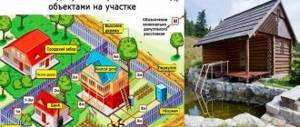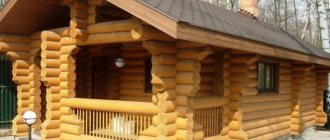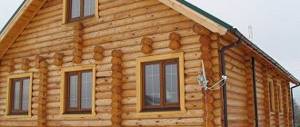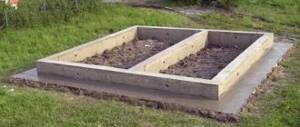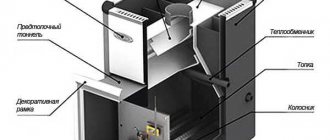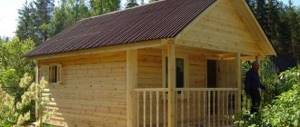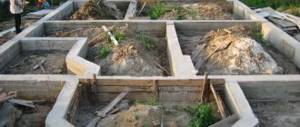The solidity of the building itself depends on the foundation, so the choice and construction of the foundation should be taken with full responsibility. Today, more and more land owners prefer foundations on tires. This is an inexpensive, prefabricated option and a creative way to build a DIY sauna base. Can be used in any climatic conditions.
Design features of a rubber foundation
Car tires are a relatively new type of building foundation. It was created at the end of the last century, combining the parameters of sustainability and efficiency. This type of foundation is also called Semykin, as it was created by St. Petersburg resident Mikhail Semykin. Most often, tires from trucks, as well as agricultural and special equipment, such as tractors or large snow removal units, are used to build a bathhouse. They have a large diameter, so the weight of the bath is distributed more evenly. But you can take passenger vehicle tires, you’ll just need a large quantity of them.
Tire rubber has valuable properties such as water resistance, vibration absorption, elasticity, and weather resistance. It resists abrasion and repeated stretching and bending well, and the process of its decomposition takes more than 100 years. There are other advantages of tires.
- The cheapest and most durable permanent formwork with external reinforcement.
- There is no need to build and dismantle formwork.
- The ratio of height to diameter is at least 1:3, resulting in resistance to uneven settlement and freezing.
- The ability to combine into blocks in the vertical and horizontal direction using any fastenings (including curled wire), strengthen the reinforcement, and install various embedded elements.
- Various variations of filling with material to transfer load to the ground.
- Low labor costs in repairing, replacing and strengthening tires, especially when using columnar non-buried foundations, allowing you to correct errors in calculations and foundation construction technology.
- The simplicity of tying the support tires with a grillage made of reinforced concrete, steel, timber, logs, or completely abandoning it and assigning its functions to the load-bearing elements of the bathhouse.
- Easy to combine with any other types of foundations.
These qualities make it possible to create a solid foundation for the bathhouse. When increased pressure occurs on individual sections of the rubber supports, the walls of the tire begin to move apart, albeit slightly, but sufficiently to reduce the transmitted impact on the grillage or lower trim of the bathhouse.
On such a foundation you can build a bathhouse even on peat soils.
Pros and cons of foundations made from car tires
Taking into account the properties of such a material, we obtain a stable base that will withstand significant loads. From tires you can build several foundation varieties for baths: columnar, strip and solid (tile).
A foundation made of rubber elements has a number of advantages.
- Possibility of use in areas with high seismic resistance, as well as in areas with permafrost.
- The elements are not afraid of seasonal ground movements, as they are able to absorb any uneven deformations, so they can be used in heaving soil.
- Can withstand significant loads from the weight of the bath itself.
- Low volume of earthworks.
- Simplicity of design.
- It has excellent waterproofing properties: it does not absorb moisture from the soil, which prevents the bottom lining of the bathhouse from getting wet.
- Durable.
- Quick and easy to construct. One person is enough for the work. There is no need for heavy construction equipment.
- Much cheaper than other types of bases.
In addition, a tire foundation is a good way to dispose of the huge number of car wheels in landfills, which are harmful to the environment.
The disadvantages of rubber foundations made from tires are their destruction and the release of harmful substances when exposed to direct sunlight. To prevent this from happening, it is enough to cover the rubber with protective materials.
If you don’t like the look of the tire foundation, you can do external finishing so that the overall appearance of the bathhouse does not suffer. Disadvantages also include the need to construct only frame structures of the building and the impossibility of using a tire base in hilly areas.
Advantages and disadvantages of the technique
Tire foundations have several advantages:
- Availability. Old tires can be found in a garage or nearby auto repair shop. You can use your own car to deliver the material.
- Rubber can withstand heat, frost, temperature changes, and high levels of humidity.
- Tires are designed to withstand significant loads and do not deform under the weight of the building.
- The shape of the tires provides sufficient waterproofing.
- In regions with increased seismic activity, tires prevent the appearance of cracks in walls.
- To make a base for construction, you do not need special education or skills.
But such a foundation also has several disadvantages:
- It is not recommended to use the foundation for the construction of a permanent house;
- tires cannot be laid directly on the ground; when heated from the ground, the material emits harmful fumes;
- There is a risk of misalignment; you need to ensure that the tires are located at the same level.
Preparation for construction
Foundation design is an important aspect of the preliminary construction stage. In the process of its implementation, it is necessary to create a detailed drawing of the future bathhouse, taking into account the structural features and indicating the dimensions. The project can be done either independently or using computer programs.
The selection and acquisition of materials is the second point of work. To build a rubber foundation, old decommissioned tires are used. They must be intact, without breaks. Tire wear doesn't matter. Their size is selected individually, depending on preferences and availability - from tires for cars and trucks to agricultural and special equipment such as tractors or large snowblowers.
The larger the diameter of the tires, the better their durability. It is necessary to choose tires of the same diameter and thickness, as this will greatly simplify the work. You also need to take care in advance of delivering the required amount of this material to the construction site.
Next, measurements and calculations are performed. Let's say you decide to build a continuous covering. First you need to calculate the required number of tires for the construction of a rubber foundation. For clarity, let’s calculate using an example, for which we take average statistical data. The original dimensions of the bathhouse base: 4 m long and 3 m wide. The outer diameter of the tire is the sum of the seat diameter (indicated in inches) and the height, which is indicated in the marking.
Let's say the mark on a tire 205/60/R15 indicates a tire width of 205 mm, a tire height of 60% of the width, and a seat diameter of 15 inches. The outer diameter will be the sum of the seat diameter (15 inches = 38.1 cm, since 1 inch is equal to 2.54 cm) and the tire height (205 mm x 60% = 123 mm), multiplied by two. That is, for a tire marked 205/60/R15, the outer diameter is 38.1 cm + (2 x 12.3 cm) = 62.7 cm or 0.627 m.
Having decided on the initial data, we perform the calculation. Let's say with these numbers.
| Algorithm | Examples |
| Divide the length of the base of the bath by the tire diameter | 4 m: 0.627 m = 6.38 pcs. |
| We also divide the width of the bathhouse base by the tire diameter. | 3 m: 0.627 m = 4.78 pcs. |
| The resulting data is multiplied and then rounded up. | 6.38 x 4.78 = 30 pcs. |
Thus, to build a rubber foundation, in our case we will need 30 tires. They can be laid in one layer, then the height of the base will be equal to the width of the tire, or in 2-3 layers. As a result, the foundation will be 41 cm–61.5 cm high, since the width of the tire, based on the markings, is 205 mm or 20.5 cm.
To create a tire base, you will need the following materials and tools.
- tires;
- shovels;
- boards or pipes for tamping;
- fragments of bricks, gravel;
- sand;
- roofing felt or linoleum;
- formwork boards for constructing a solid foundation made of tires;
- fittings;
- building level.
Before constructing a tire foundation, preliminary work is carried out to prepare the construction site: the area is cleared of stones and debris, and the top layer of earth 30 cm thick is removed.
Only a wooden structure should rest on a foundation made of tires, since wood has elasticity and is not afraid of small vibrations. In brick buildings, cracks form due to their sensitivity to even the slightest shifts. Therefore, it is not recommended to build a block or brick bathhouse on it.
Stages of work execution
Let's look at how to build a foundation on tires with your own hands. When constructing a solid foundation, perform the following activities:
- Develop a design for the foundation of the building that corresponds to the size and weight of the future structure.
- Mark the area for the future foundation using pegs and a cord stretched along the contour of the building.
Tire foundations are used in construction in the form of pillars
- Check the angles of the base by comparing the lengths of the diagonals. The correspondence of the sizes of the diagonals confirms the presence of right angles of the future foundation.
- Remove the soil at the construction site, ensuring the thickness of the removed layer is 30 cm.
- Plan the surface of the pit and, if necessary, compact the soil.
- Fill the pit with tires laid flat, ensuring they touch the side surfaces.
- Fill the tires with broken bricks, stones, gravel, and compact the mass thoroughly.
- Install wooden or metal formwork along the contour of the building, ensuring that the height of the formwork panels exceeds the level of the slopes by 10 cm.
- Place roofing felt or plastic film on the surface of the supports.
- Prepare a concrete solution based on M400 Portland cement, crushed sand and water.
- Fill the formwork with concrete, forming a solid slab, the dimensions of which correspond to the geometry of the building being constructed.
- Remove air pockets when pouring concrete using rebar.
- Allow the concrete to hydrate for 4 weeks.
After the concrete mass has acquired operational characteristics, it is possible to carry out measures for the further construction of the building.
The process of erecting individual supports based on tires from heavy-duty vehicles involves a similar amount of preparatory operations at the construction site. Remove soil, level and compact. Having given preference to a columnar base, after preparing the site, perform the following activities:
- place the bottom row of tires at the corners and intersection points of the walls of the building, ensuring the location of the axis of the slopes corresponds to the markings;
- check the horizontality of the supporting surfaces using a building level;
- lay the second row of slopes, waterproof the inside;
- fill the internal cavity with crushed stone, moistening and compacting the mass in layers;
- prepare a concrete solution;
- pour concrete mortar over the crushed stone compacted in the slopes.
If necessary, channels can be laid on the tires along the perimeter of the building, which will unite the supporting structure into a single power circuit. All that remains is to remove the air cavities, allow the solution to harden, and after a month you can continue construction.
Construction of a rubber foundation from tires
In order for the base made of tires to serve for a long time and at the same time reliably hold the bathhouse, it is necessary to correctly perform all the work on its installation, as well as provide reliable protection from exposure to sunlight. The main criterion when creating a foundation from car tires is control of their positions in the same plane and at the same level. Errors here can lead to distortion of the entire foundation.
The construction of a slab foundation consists of several stages.
- They dig a pit 20 cm deep according to the dimensions of the future bathhouse, retreating 20 cm along the perimeter. This measure is necessary so that when concreting the outer edges of the tires are also covered. This will not only strengthen the base, but also prevent the release of harmful substances under the influence of sunlight. The depth of the hole does not depend on the thickness of the tires.
- Checking the water level, level the bottom of the pit, constantly compacting it.
- The tires are laid flat on a flat surface, close to each other. Inside each of them we lay roofing material, which will prevent the stuffing from spilling out and serve as additional waterproofing.
- The space inside the tires is filled with earth, sand, gravel or construction waste, compacted with a pipe or board with a handle. Similar actions are carried out between the tires, filling the gaps. The denser the material is compacted, the better and more reliable the foundation of the bathhouse will be. Do not fill the rubber on top: the filling should be located at the same level as the top side of the tire.
- To ensure that the concrete pour is uniform, roofing material or linoleum is spread on the prepared surface. One layer of such coating is sufficient if the strips are laid with an overlap of at least 5 cm.
- Around the laid tires, formwork is installed from waste boards or plywood 10–15 cm high.
- Reinforcement is placed on roofing felt in the internal space of the formwork and tied together with steel wire or welding is used. To secure the structures of the walls and partitions of the future bathhouse, anchors are attached to the reinforcement frame and placed above the concrete level.
- Fill with plastic concrete to the height of the formwork, which will serve as the upper part of the tire base. It is important to ensure that it is horizontal using a building level. Deviations from the concreting plane should not exceed 10 mm per 1 meter.
- Next, a lower frame of the bathhouse made of timber or metal channels is erected on it, which is attached to the anchors.
To speed up the hardening of concrete, use old rags soaked in ammonia.
They are laid on the pouring surface and covered with polyethylene. This measure helps to extract moisture from the concrete, which helps to achieve the required strength within a week. Some land owners do not fill tires with concrete, but buy a ready-made reinforced concrete slab. But such a foundation will cost much more than one made by yourself.
A foundation made from tire posts is also reliable, although it has less load-bearing capacity. It differs from a tiled base in that the free-standing tire columns inside are filled with concrete. First, markings are made around the perimeter of the future bathhouse using pegs. Tires are placed on the pegs, and anchors are inserted inside them. Each tire is filled with stones, broken bricks or gravel and poured with concrete. Don't forget to place pieces of linoleum or roofing felt under the tires. The tires should be at the same level in the corners of the bathhouse and intermediate nodes.
The main stages of arranging a building support
The foundation made of wheel material can be of two types:
- tiled;
- columnar.
Tiled
In the first case, to build a foundation, tires are laid under the base slab of the structure. To build a foundation, you can use a simple technology that includes the following steps:
- The first step is to prepare the site for the construction of the foundation. To do this, it is necessary to remove the fertile layer of soil in the area intended for the construction of the foundation. The fact is that the so-called humus contains a considerable amount of substances and microorganisms that can cause the destruction of concrete and other materials. As a rule, the fertile layer is no more than 25 centimeters. The surface obtained after removing the soil layer must be leveled using a building level.
- Car tires are laid out on a leveled area. You can also use tractor or bus tires. It is advisable to choose tires with a larger diameter, as they can provide better protection against moisture and greater stability and reliability of the structure. Tires must be placed flat, close to each other. When arranging a base of tires with your own hands, the number of layers is determined depending on the thickness of the tires used. For example, it is enough to lay tractor tires in one layer.
- It is advisable to lay ordinary car tires in two rows. In addition, when choosing the height of the foundation and laying tires, you need to take into account the characteristics of the terrain and soil. If the soil is a swampy, unreliable area with high humidity, it is better to make the base higher so that the structure is raised as high as possible above ground level and does not come into contact with moisture.
- Also, do not forget about the underground or basement. If you plan to install them in your home, you need to decide on the location in advance and not place tires in the selected area. Empty gaps will form between the tires during the laying process; it is advisable not to leave them in this form, but to fill them with gravel or broken bricks. It is not recommended to use sand and crushed stone for these purposes, since the base under their influence can cause severe shrinkage.
- The next layer on the tires is roofing felt. You can also use other roll materials, however, roofing felt is the most suitable, based on the characteristics and price-quality ratio.
- A formwork made of wooden boards is installed on top of the roofing felt. The height of the sides should be approximately 15 centimeters.
- Next, concrete mortar is poured into the prepared wooden boxes. At the end of the work, you need to leave the concrete for up to ten days so that it dries completely. The formwork cannot be removed before this date.
Columnar
Do-it-yourself columnar foundations made of tires are arranged somewhat differently. In this case, the technology involves the use of tires as supporting pillars of the structure.
- In order to correctly install tires, you first need to calculate the exact location of the future structure and outline where exactly the corners will be placed.
- Next, as in the case of a slab foundation, it is necessary to prepare the site. First, the fertile layer is removed. After this, you need to dig a foundation pit over the entire area of the future building. The soil inside the recess is well compacted and leveled, after which a layer of fine crushed stone is poured onto the bottom. After this, you need to drive small posts in the place where the tires are installed and measure the distance between the proposed supports. The deflection should not be large so that the load is distributed evenly across all supports.
- Then tires are put on the pegs, leveled and covered with crushed stone. A well formed by several layers of tires must be completely filled with crushed stone. Next, a layer of roofing felt is laid on top of the tire, and then formwork is installed, which is then filled with concrete. After the solution has dried, you need to lay the bottom trim made of timber.
Strip foundation on rubber tires
It is erected on soils that have low bearing capacity or a large freezing depth, which is facilitated by the sufficient width of the tires, providing a significant area for load distribution. The construction is similar to the technology of constructing a solid base, but differs in some nuances. The position of the axes of the load-bearing walls and partitions of the bathhouse is determined on the ground and secured with pegs located no closer than a meter from the axis. This is very important because the load must be transferred in the middle.
A trench is dug along the intended axes, the width of which is 10–20 centimeters greater than the width of the tire, and the depth is necessarily less than the depth of soil freezing. At least two rows of tires are placed in the trench and filled with bulk material. Metal rods are inserted inside the tires as anchors for tying to the bottom of the bathhouse. The installation of the strip base is completed by pouring concrete.
After constructing a foundation for a bathhouse from tires, the protrusions that formed when laying the foundation under the structure can be easily decorated with any building material, which will give the structure an aesthetic appearance. A foundation made from old, used tires does not require special care. If it is positioned correctly and protected from the sun at the initial stage, then during subsequent use it will not cause any trouble.
A foundation made of tires is the optimal and economical option for building a base for a bathhouse. And how to lay it, everyone decides for themselves. The main thing is good knowledge, the necessary construction supplies and a great desire.
For which buildings are tire bases used?
Tire foundations are not suitable for every home construction.
Before deciding to use this type of foundation, you need to study the geological features of the area and compare the weight of the building with the load-bearing capacity of these products.
It is important to calculate all the pros and cons so that it does not turn out that the savings at the first stage will lead to significant costs during operation.
Used for foundation construction:
- baths;
- gazebos;
- sheds;
- garages;
- summer kitchens;
- small light buildings.
A foundation made of tires for a gazebo, decorated with timber, natural or artificial stone, will look beautiful.
A base made from old tires is perfect for constructing small buildings, but it can behave unpredictably when used in the construction of large objects.
